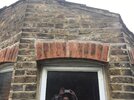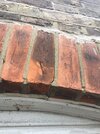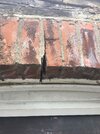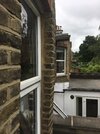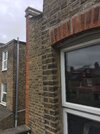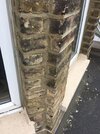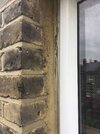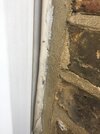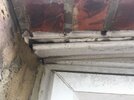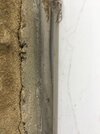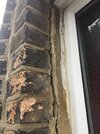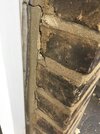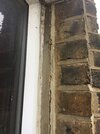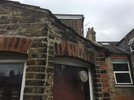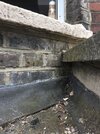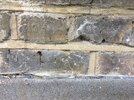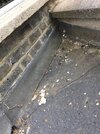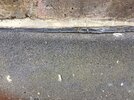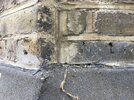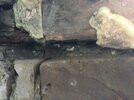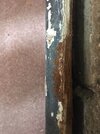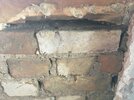I decided to finally deal with some blown plaster around a kitchen window, and ended up removing all of the plaster below one of the windows, which came away easily.
Underneath, the brick seemed slightly damp, which is strange given all the hot weather we've had recently.
At either ends the wood below the sill is spongy and rotten, and the inside of the skirting is the same. The mortar between bricks was also very crumbly/dusty, and I've removed most of the looser sections.
Around 8 years ago my neighbours downstairs had an extension built, which includes a flat roof and parapet wall below my kitchen bay windows.
It seems to be running off correctly, but there may be a problem related to this. The builders identified a crack around my windows at the time, which they repaired, by the looks of it with concrete.
The double glazed windows are probably 25-30 years old, so I inspected them properly, and found a whole load of worrying problems, although no signs of blocked drainage or a failed inner seal.
On the outside I did find failed caulk, cracks in mortar, blown brick faces, what looks like it could be salt deposits, and worst of all, severely bowing walls.
Above these windows is a sloping roof. at some point in the building's history this and the upper main roof were replaced with concrete tiles.
There is also a slight bow on the outside wall along the side of the building, which a surveyor has looked at and said is not ideal but also not in need of a rebuild. I had leaks from under the top floor parapet wall, but that's a separate issue, and the completely redone flat roof up there seems to be ok.
To me this looks pretty bad, and possibly not fixable with re-rendering, but am I over-reacting?
A lot of photos I know, but I tried to document all the problems in a way that's clear to see.
The house is semi-detached, and there is a passageway along one side, which may contribute to subsidence. Also, heavy lorries hitting speed bumps cause massive vibration and shaking which could be damaging the foundations.
Underneath, the brick seemed slightly damp, which is strange given all the hot weather we've had recently.
At either ends the wood below the sill is spongy and rotten, and the inside of the skirting is the same. The mortar between bricks was also very crumbly/dusty, and I've removed most of the looser sections.
Around 8 years ago my neighbours downstairs had an extension built, which includes a flat roof and parapet wall below my kitchen bay windows.
It seems to be running off correctly, but there may be a problem related to this. The builders identified a crack around my windows at the time, which they repaired, by the looks of it with concrete.
The double glazed windows are probably 25-30 years old, so I inspected them properly, and found a whole load of worrying problems, although no signs of blocked drainage or a failed inner seal.
On the outside I did find failed caulk, cracks in mortar, blown brick faces, what looks like it could be salt deposits, and worst of all, severely bowing walls.
Above these windows is a sloping roof. at some point in the building's history this and the upper main roof were replaced with concrete tiles.
There is also a slight bow on the outside wall along the side of the building, which a surveyor has looked at and said is not ideal but also not in need of a rebuild. I had leaks from under the top floor parapet wall, but that's a separate issue, and the completely redone flat roof up there seems to be ok.
To me this looks pretty bad, and possibly not fixable with re-rendering, but am I over-reacting?
A lot of photos I know, but I tried to document all the problems in a way that's clear to see.
The house is semi-detached, and there is a passageway along one side, which may contribute to subsidence. Also, heavy lorries hitting speed bumps cause massive vibration and shaking which could be damaging the foundations.
Attachments
-
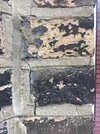 blown brick face (2).jpeg413.6 KB · Views: 81
blown brick face (2).jpeg413.6 KB · Views: 81 -
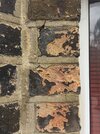 blown brick face.jpeg362.5 KB · Views: 80
blown brick face.jpeg362.5 KB · Views: 80 -
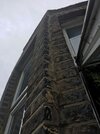 bowing (1).jpeg148.4 KB · Views: 73
bowing (1).jpeg148.4 KB · Views: 73 -
 bowing (2).jpeg160 KB · Views: 75
bowing (2).jpeg160 KB · Views: 75 -
 bowing (3).jpeg123.2 KB · Views: 75
bowing (3).jpeg123.2 KB · Views: 75 -
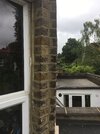 bowing (4).jpeg177 KB · Views: 72
bowing (4).jpeg177 KB · Views: 72 -
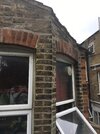 bowing (5).jpeg178.6 KB · Views: 75
bowing (5).jpeg178.6 KB · Views: 75 -
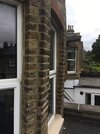 bowing (6).jpeg175.6 KB · Views: 70
bowing (6).jpeg175.6 KB · Views: 70 -
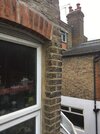 bowing (7).jpeg192 KB · Views: 63
bowing (7).jpeg192 KB · Views: 63 -
 blown brick face (1).jpeg239.5 KB · Views: 78
blown brick face (1).jpeg239.5 KB · Views: 78



